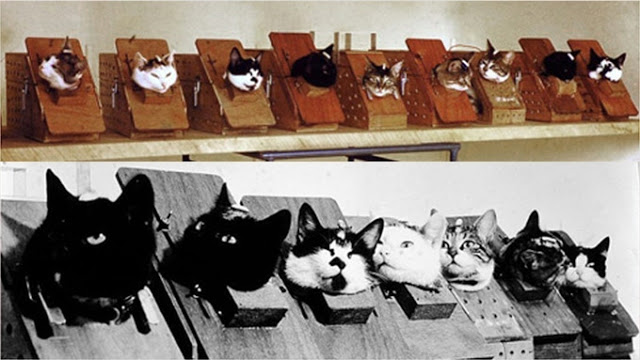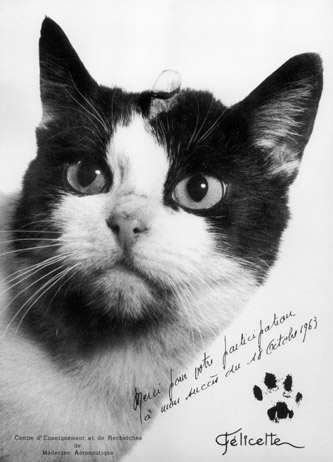 |
| From Matthew Serge Guy’s Kickstarter, “The Meow-cury 14”: “The cats in training harnesses. Félicette on bottom right.” |
On November 7, 2010, over seven years ago, I published an (admittedly not very good) blog post about the story of France’s first space cat, Félix. The problem is…there was never a space cat named Félix. Read more about how I messed up, contributed to a falsehoodconcerning animals in space, and how a Kickstarter begun by Matthew Serge Guy intends to right these wrongs and honor the first real kitty who went to space.
Space Myths Busted: How Did I Mess Up This Badly?
My 2010 post read, “In 1963, France – for some unknown reason – decided it would be a cool idea to send a cat into space. French rocket propulsion engineers interviewed thousands of prospective space chats (or les chatstronauts) for this historic mission.
Unfortunately, this took quite a while, since most French cats can be found eating cheese, drinking wine, and smoking tons of cigarettes at coffeehouses. However, one heroic cat – Félix – was found at the gym doing push-ups, running on a tiny treadmill, and lifting weights. He was the clearly the perfect specimen for spaceflight, and on October 18, 1963, he became the first ever space kitty. Félix was recovered very much alive and meowing.”
Turns out, all I got correct here was the launch date. The cat actually launched on a suborbital flight aboard a Veronique AG1 rocket on that date from Hammaguir, Algeria was a tuxedo lady named Félicette, who allegedly possessed a chill attitude and most definitely had a sweet face. According to the Kickstarter, “There are conflicting stories on whether the French space programme simply found Félicette as a stray on the streets of Paris, or if she was purchased from a cat dealer. Either way, she became one of 14 cats put into training for this spaceflight mission. Ultimately Félicette was chosen, apparently due to her calm nature. But other reports indicate it may have been because the other 13 cats had put on too much weight.” Fancy Feast’s loss was the world’s gain, and soon the “Astrocat” was space-bound.
 |
| Photo from CNES, France’s space agency: “Chatte Félicette.” The inscription reads, “Thank you for your participation in my success on 18 October 1963.” Note the electrodes visible at the top of her head. |
Félicettespent five minutes weightless, and her flight totaled 15 minutes. Her capsule reached an altitude of 157 kilometers (approximately 98 miles). By all reports, she – and not some other boy cat – arrived back on terra firma healthy and meowing.
So how did everyone, including me,confuse Félicette with Félix? According to a Space.com article, many claimed Félicette was a backup cat for Félix, a cat that most likely never even existed. Also, the piece states that Félicette was often labeled as “Félix” on stamps commemorating the mission. This probably furthered the confusion. At any rate, a lot of literature until recent years identified the first French space cat as Félix.
What Happened To Félicette?
Sadly, the world’s first space cat’s story does not have the happiest ending. Prior to her flight, electrodeswereimplanted in her brain to study the effects of spaceflight. The Kickstarter page explains, “After her successful flight, reports indicate Félicette returned to the French space programme’s laboratory for 2 or 3 months of further study. She was then sadly put to sleep, in order to further analyse the electrodes implanted in her brain.”
The spaceflight landscape is littered with unfortunate stories such as these (see also the Soviet space dog Laika, who died from heat exhaustion during her Sputnik 2 mission,and the U.S. rhesus monkey Miss Able, who died during a medical procedure after her successful mission) – animals sacrificing their lives to better the study of high acceleration and low gravity. The difference here is that there is no monument memorializing and honoring the intrepid first space cat.
The Kickstarter aims to change that; it ends this Friday, November 17, and the campaign is looking for £40,000 ($52,760 in U.S. dollars) to install a bronze statue of the brave space kitty in her hometown, Paris.
Emily Carney is a writer, space enthusiast, and creator of the This Space Available space blog, published since 2010. In January 2019, Emily’s This Space Available blog was incorporated into the National Space Society’s blog. The content of Emily’s blog can be accessed via the This Space Available blog category.
Note: The views expressed in This Space Available are those of the author and should not be considered as representing the positions or views of the National Space Society.


















